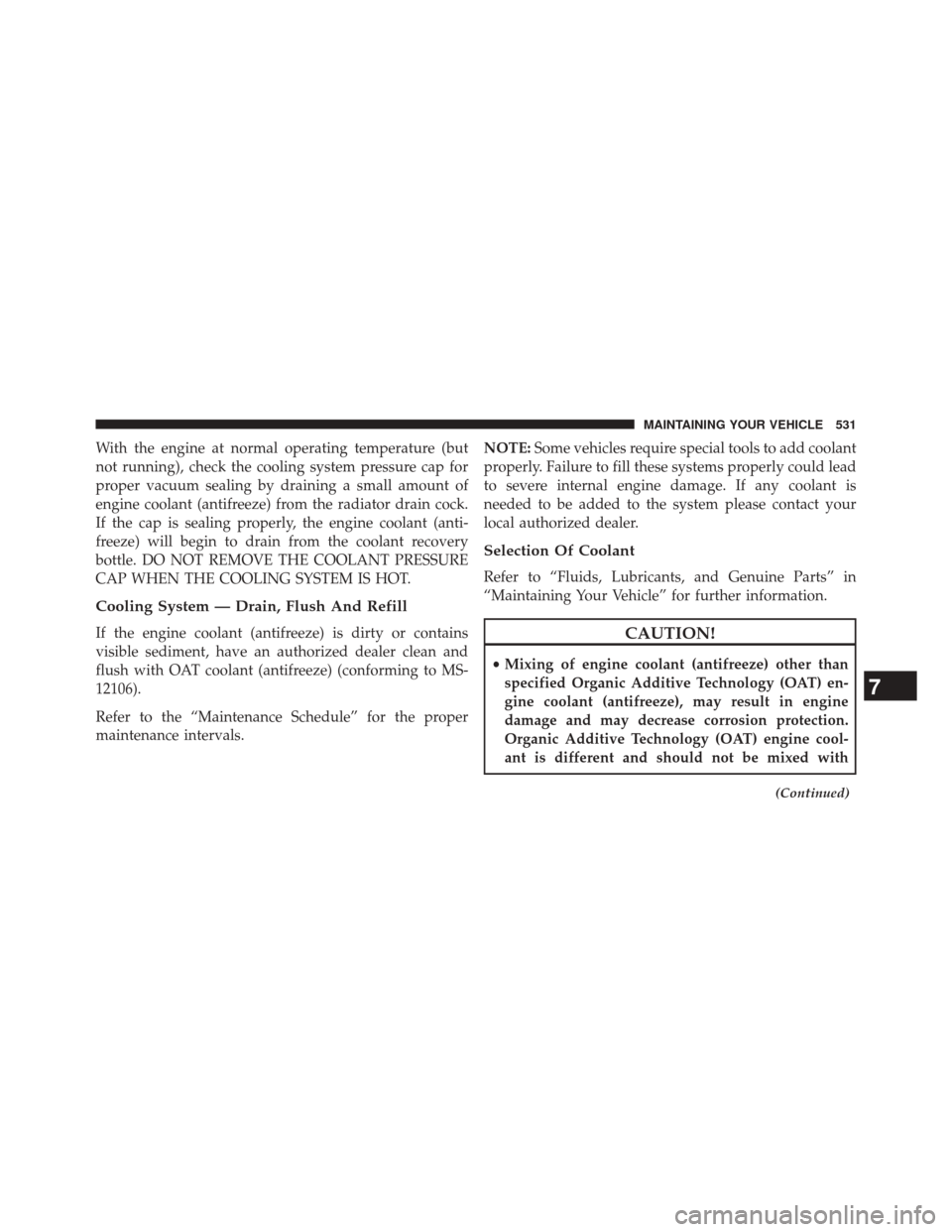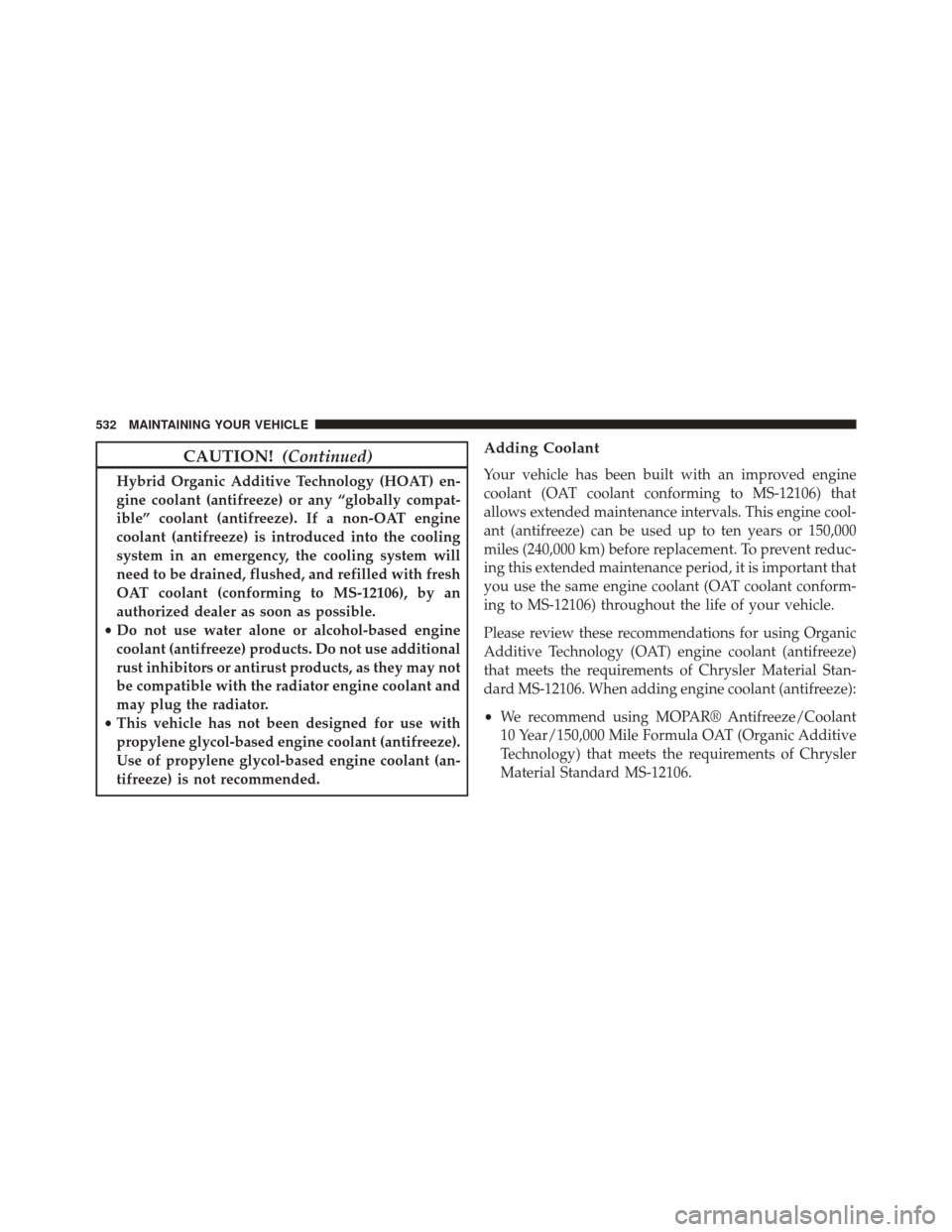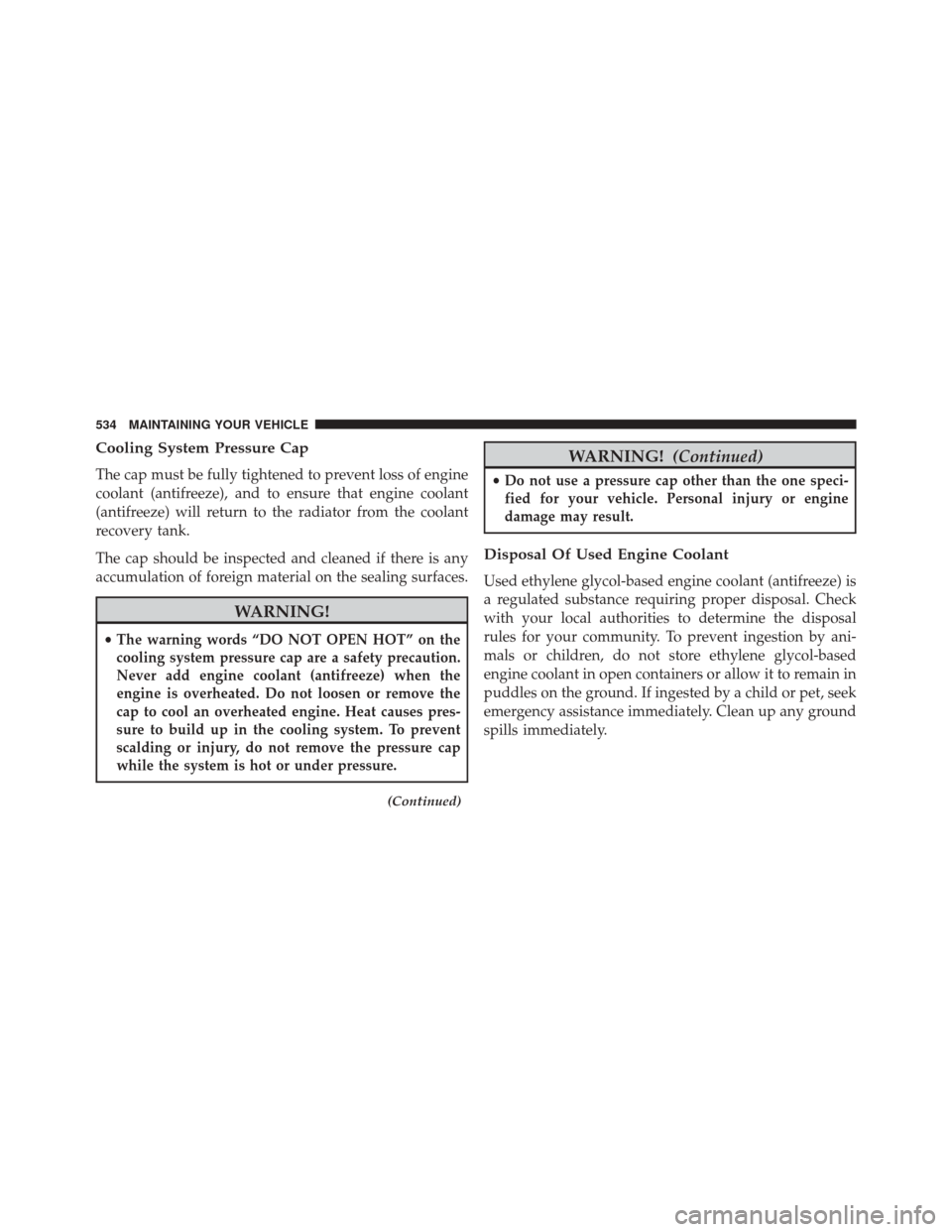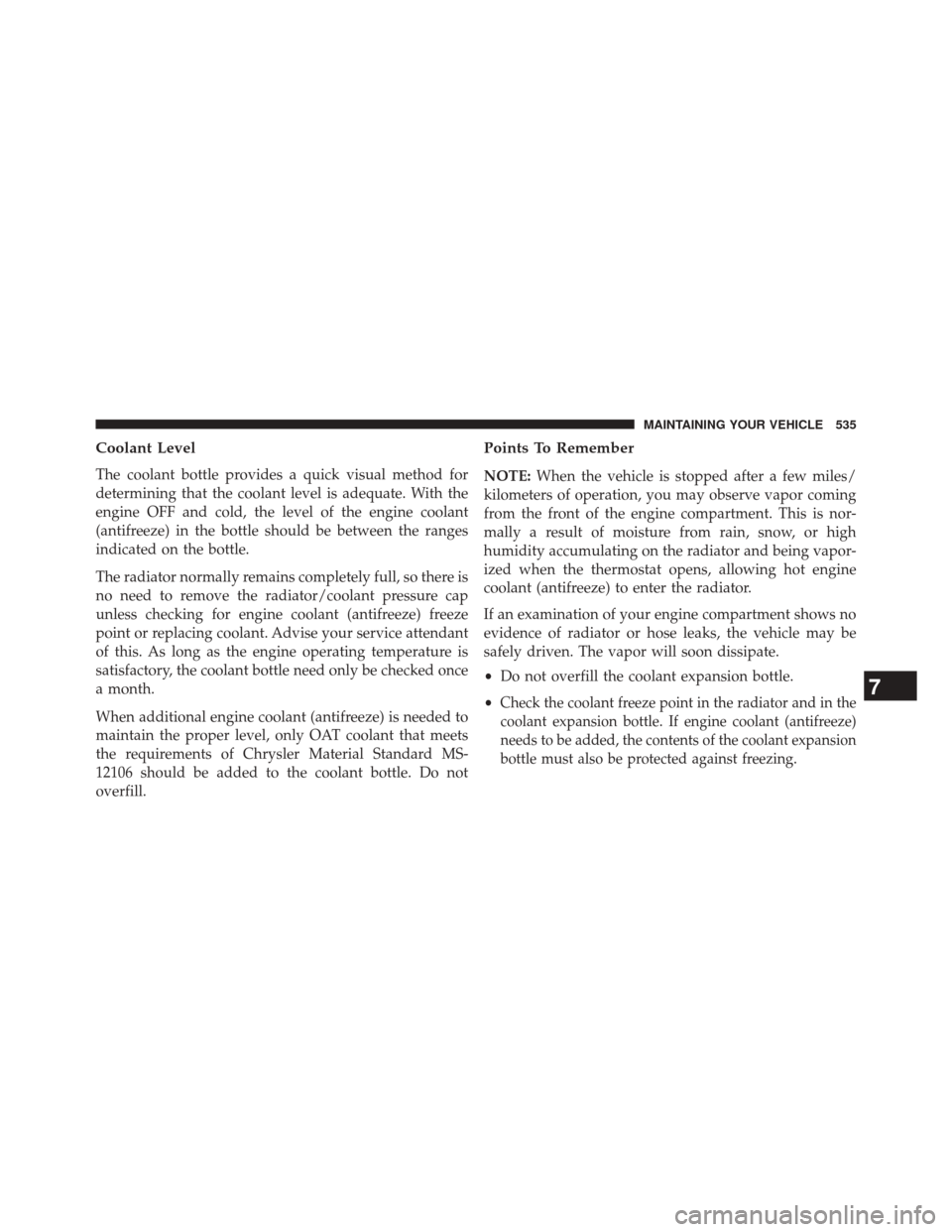2014 JEEP GRAND CHEROKEE radiator
[x] Cancel search: radiatorPage 533 of 615

With the engine at normal operating temperature (but
not running), check the cooling system pressure cap for
proper vacuum sealing by draining a small amount of
engine coolant (antifreeze) from the radiator drain cock.
If the cap is sealing properly, the engine coolant (anti-
freeze) will begin to drain from the coolant recovery
bottle. DO NOT REMOVE THE COOLANT PRESSURE
CAP WHEN THE COOLING SYSTEM IS HOT.
Cooling System — Drain, Flush And Refill
If the engine coolant (antifreeze) is dirty or contains
visible sediment, have an authorized dealer clean and
flush with OAT coolant (antifreeze) (conforming to MS-
12106).
Refer to the “Maintenance Schedule” for the proper
maintenance intervals.NOTE:
Some vehicles require special tools to add coolant
properly. Failure to fill these systems properly could lead
to severe internal engine damage. If any coolant is
needed to be added to the system please contact your
local authorized dealer.
Selection Of Coolant
Refer to “Fluids, Lubricants, and Genuine Parts” in
“Maintaining Your Vehicle” for further information.
CAUTION!
• Mixing of engine coolant (antifreeze) other than
specified Organic Additive Technology (OAT) en-
gine coolant (antifreeze), may result in engine
damage and may decrease corrosion protection.
Organic Additive Technology (OAT) engine cool-
ant is different and should not be mixed with
(Continued)
7
MAINTAINING YOUR VEHICLE 531
Page 534 of 615

CAUTION!(Continued)
Hybrid Organic Additive Technology (HOAT) en-
gine coolant (antifreeze) or any “globally compat-
ible” coolant (antifreeze). If a non-OAT engine
coolant (antifreeze) is introduced into the cooling
system in an emergency, the cooling system will
need to be drained, flushed, and refilled with fresh
OAT coolant (conforming to MS-12106), by an
authorized dealer as soon as possible.
• Do not use water alone or alcohol-based engine
coolant (antifreeze) products. Do not use additional
rust inhibitors or antirust products, as they may not
be compatible with the radiator engine coolant and
may plug the radiator.
• This vehicle has not been designed for use with
propylene glycol-based engine coolant (antifreeze).
Use of propylene glycol-based engine coolant (an-
tifreeze) is not recommended.
Adding Coolant
Your vehicle has been built with an improved engine
coolant (OAT coolant conforming to MS-12106) that
allows extended maintenance intervals. This engine cool-
ant (antifreeze) can be used up to ten years or 150,000
miles (240,000 km) before replacement. To prevent reduc-
ing this extended maintenance period, it is important that
you use the same engine coolant (OAT coolant conform-
ing to MS-12106) throughout the life of your vehicle.
Please review these recommendations for using Organic
Additive Technology (OAT) engine coolant (antifreeze)
that meets the requirements of Chrysler Material Stan-
dard MS-12106. When adding engine coolant (antifreeze):
• We recommend using MOPAR® Antifreeze/Coolant
10 Year/150,000 Mile Formula OAT (Organic Additive
Technology) that meets the requirements of Chrysler
Material Standard MS-12106.
532 MAINTAINING YOUR VEHICLE
Page 536 of 615

Cooling System Pressure Cap
The cap must be fully tightened to prevent loss of engine
coolant (antifreeze), and to ensure that engine coolant
(antifreeze) will return to the radiator from the coolant
recovery tank.
The cap should be inspected and cleaned if there is any
accumulation of foreign material on the sealing surfaces.
WARNING!
•The warning words “DO NOT OPEN HOT” on the
cooling system pressure cap are a safety precaution.
Never add engine coolant (antifreeze) when the
engine is overheated. Do not loosen or remove the
cap to cool an overheated engine. Heat causes pres-
sure to build up in the cooling system. To prevent
scalding or injury, do not remove the pressure cap
while the system is hot or under pressure.
(Continued)
WARNING! (Continued)
•Do not use a pressure cap other than the one speci-
fied for your vehicle. Personal injury or engine
damage may result.
Disposal Of Used Engine Coolant
Used ethylene glycol-based engine coolant (antifreeze) is
a regulated substance requiring proper disposal. Check
with your local authorities to determine the disposal
rules for your community. To prevent ingestion by ani-
mals or children, do not store ethylene glycol-based
engine coolant in open containers or allow it to remain in
puddles on the ground. If ingested by a child or pet, seek
emergency assistance immediately. Clean up any ground
spills immediately.
534 MAINTAINING YOUR VEHICLE
Page 537 of 615

Coolant Level
The coolant bottle provides a quick visual method for
determining that the coolant level is adequate. With the
engine OFF and cold, the level of the engine coolant
(antifreeze) in the bottle should be between the ranges
indicated on the bottle.
The radiator normally remains completely full, so there is
no need to remove the radiator/coolant pressure cap
unless checking for engine coolant (antifreeze) freeze
point or replacing coolant. Advise your service attendant
of this. As long as the engine operating temperature is
satisfactory, the coolant bottle need only be checked once
a month.
When additional engine coolant (antifreeze) is needed to
maintain the proper level, only OAT coolant that meets
the requirements of Chrysler Material Standard MS-
12106 should be added to the coolant bottle. Do not
overfill.
Points To Remember
NOTE:When the vehicle is stopped after a few miles/
kilometers of operation, you may observe vapor coming
from the front of the engine compartment. This is nor-
mally a result of moisture from rain, snow, or high
humidity accumulating on the radiator and being vapor-
ized when the thermostat opens, allowing hot engine
coolant (antifreeze) to enter the radiator.
If an examination of your engine compartment shows no
evidence of radiator or hose leaks, the vehicle may be
safely driven. The vapor will soon dissipate.
• Do not overfill the coolant expansion bottle.
•
Check the coolant freeze point in the radiator and in the
coolant expansion bottle. If engine coolant (antifreeze)
needs to be added, the contents of the coolant expansion
bottle must also be protected against freezing.7
MAINTAINING YOUR VEHICLE 535
Page 538 of 615

•If frequent engine coolant (antifreeze) additions are
required, the cooling system should be pressure tested
for leaks.
• Maintain engine coolant (antifreeze) concentration at
a minimum of 50% OAT coolant (conforming to
MS-12106) and distilled water for proper corrosion
protection of your engine which contains aluminum
components.
• Make sure that the coolant expansion bottle overflow
hoses are not kinked or obstructed.
• Keep the front of the radiator clean. If your vehicle is
equipped with air conditioning, keep the front of the
condenser clean.
•
Do not change the thermostat for Summer or Winter
operation. If replacement is ever necessary, install ONLY
the correct type thermostat. Other designs may result in
unsatisfactory engine coolant (antifreeze) performance,
poor gas mileage, and increased emissions.
Brake System
In order to assure brake system performance, all brake
system components should be inspected periodically.
Refer to the “Maintenance Schedule” for the proper
maintenance intervals.
WARNING!
Riding the brakes can lead to brake failure and
possibly a collision. Driving with your foot resting or
riding on the brake pedal can result in abnormally
high brake temperatures, excessive lining wear, and
possible brake damage. You would not have your full
braking capacity in an emergency.
Fluid Level Check — Brake Master Cylinder
The fluid level of the master cylinder should be checked
whenever the vehicle is serviced, or immediately if the
brake system warning light is on. If necessary, add fluid
to bring level to the full mark on the side of the reservoir
536 MAINTAINING YOUR VEHICLE
Page 599 of 615

Auxiliary Electrical Outlet (Power Outlet)........270
Auxiliary Power Outlet .....................270
Battery ................................ .314
Charging ............................ .314
Keyless Transmitter Replacement (RKE) ........25
Belts, Seat ...............................53
Blind Spot Monitoring ..................... .135
Body Mechanism Lubrication .................524
B-Pillar Location ......................... .434
Brake Assist System ...................... .419
Brake Control System, Electronic ..............418
Brake Fluid ............................ .536
Brake System ........................... .536
Anti-Lock (ABS) ....................... .418
Fluid Check .......................... .536
Master Cylinder ....................... .536
Parking ............................. .415
Warning Light ........................ .300Brake/Transmission Interlock
.................398
Break-In Recommendations, New Vehicle ........111
Bulb Replacement ........................ .556
Bulbs, Light .............................116
Camera, Rear ........................... .247
Capacities, Fluid ......................... .563
Caps, Filler Oil (Engine) .......................... .518
Radiator (Coolant Pressure) ................534
Carbon Monoxide Warning ..................112
Cargo Area Cover ........................ .284
Cargo Area Features ...................... .280
Cargo Compartment ...................... .280
Light ............................... .282
Cargo Light ............................ .282
Cargo Tie-Downs ........................ .285
Car Washes ............................ .542
Cellular Phone .......................... .374
10
INDEX 597
Page 600 of 615

Center High Mounted Stop Light..............562
Certification Label ........................ .467
Chart, Tire Sizing ........................ .429
Check Engine Light
(Malfunction Indicator Light). . .512
Checking Your Vehicle For Safety ..............112
Checks, Safety ............................112
Children Too Large For Booster Seats ............90
Child Restraint ............................85
Child Safety Locks .........................34
Clean Air Gasoline ....................... .460
Cleaning Wheels .............................. .544
Climate Control ......................... .374
Cold Weather Operation ....................395
Compact Disc (CD) Maintenance ..............373
Compact Spare Tire ....................... .444
Console, Overhead ....................... .250
Contract, Service ......................... .589
Coolant Pressure Cap (Radiator Cap) ...........534Cooling System
.......................... .530
Adding Coolant (Antifreeze) ...............532
Coolant Capacity ...................... .563
Coolant Level ......................... .530
Disposal of Used Coolant .................534
Drain, Flush, and Refill ...................531
Inspection ........................... .535
Points to Remember .....................535
Pressure Cap ......................... .534
Radiator Cap ......................... .534
Selection of Coolant (Antifreeze) .............531
Corrosion Protection ...................... .542
Cruise Control (Speed Control) ................196
Cupholders ............................ .276
Customer Assistance ...................... .587
Data Recorder, Event .......................84
Daytime Running Lights ....................175
Dealer Service ........................... .514
598 INDEX
Page 608 of 615

ParkSense System, Rear.....................228
Passing Light ........................... .182
Pets ...................................110
Pets, Transporting .........................110
Placard, Tire and Loading Information ..........434
Power Distribution Center (Fuses) ................548
Door Locks ............................33
Inverter ............................. .274
Lift Gate ..............................46
Mirrors ............................. .133
Outlet (Auxiliary Electrical Outlet) ...........270
Seats ............................... .146
Steering ............................. .414
Sunroof ............................. .262
Tilt/Telescoping Steering Column ............188
Windows ..............................41
Pregnant Women and Seat Belts ................67
Preparation for Jacking .....................490 Pretensioners
Seat Belts ..............................62
Programming Transmitters (Remote Keyless Entry). . .22
Radial Ply Tires ......................... .441
Radiator Cap (Coolant Pressure Cap) ...........534
Radio Operation ......................... .374
Radio Remote Controls .....................372
Rain Sensitive Wiper System .................186
Rear Axle (Differential) .....................538
Rear Camera ........................... .247
Rear Cross Path ......................... .142
Rear Cupholder ......................... .276
Rear ParkSense System .....................228
Rear Seat, Folding ........................ .162
Rear Window Features .....................287
Rear Wiper/Washer ....................... .287
Reclining Front Seats ...................... .151
Recorder, Event Data .......................84
606 INDEX